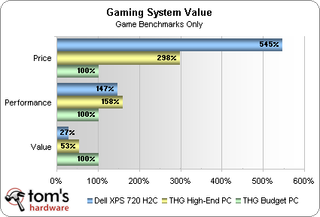What's Faster Our Builds or Dell's H2C?
Value Analysis
The Dell XPS 720 H2C came equipped with the brand's high-end 24" flat panel display, a Blu-Ray disk burner, keyboard, mouse, speakers and operating system. Since we re-use the peripherals and OS license from previous builds for our own systems, a fair value assessment required subtracting the cost of those parts from Dell's list price. Doing this brought the XPS 720 H2C down to "only" $6,400.
Most readers know that even though two cards cost twice as much as one, the performance advantage for SLI is far less than double that of a single card. This could be the budget system's first opportunity to shine as a value leader.

A 300% increase in price put our high-end system only 58% ahead of the budget configuration. With only 53% of the value rating of the lower-cost contender, the high-end build only becomes a valuable gaming asset if you can find a game that actually needs the extra graphics power.
All of our applications and most synthetic benchmarks make little use of the added graphics card of SLI systems, so we'd expect the budget PC to shine even brighter in combined value.

The smart money goes to the budget system whenever extra performance isn't mandatory. The XPS 720 H2C costs an astounding 545% more but offers less than 50% in performance. Even our more conservative high-end build costs nearly three times the price of the budget PC, and it offers only a one-third performance increase.
Stay on the Cutting Edge
Join the experts who read Tom's Hardware for the inside track on enthusiast PC tech news — and have for over 25 years. We'll send breaking news and in-depth reviews of CPUs, GPUs, AI, maker hardware and more straight to your inbox.
Most Popular


